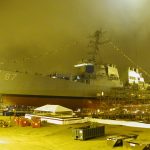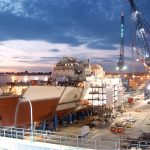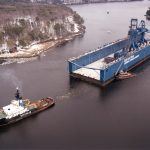In 1991, BIW celebrated the delivery and commissioning of USS Arleigh Burke (DDG 51), BIW Hull 450, the first of the Aegis destroyers. As shipbuilders took pride in delivery of a lead ship, and the rare honor of having a living namesake, no one suspected BIW would still be building DDG 51-class ships more than 25 years later. In fact, with 62 ships delivered and more under construction, the Arleigh Burke program has become the longest-running naval shipbuilding program in history, the largest class of surface combatants since WWII, and among the most successful modern shipbuilding programs.
As the last cruisers were delivered, the DDG program fell into a steady rhythm, with BIW delivering two ships each year, steadily building the Navy’s modern destroyer fleet and replacing many earlier BIW-built ships.
While shipbuilding continued at a steady pace, other changes were soon underway in the shipyard. After many years of ownership by non-shipbuilding investors, BIW was purchased by General Dynamics in 1995. Although now known as a diversified defense contractor, GD’s corporate roots stretch back to a shipyard nearly as old as BIW – the Electric Boat Corporation of 1899, one of the pioneering submarine builders.
Under General Dynamics’ ownership, BIW soon began the most significant modernization in the yard’s history. In 1998, ground was broken on the Land Level Transfer Facility (LLTF), to replace the old inclined shipways. The 15-acre facility, with three level shipways, not only expanded BIW’s footprint but also shaped the yard and shipbuilding process we know today. Thanks to land-level construction and the arrival of BIW’s new drydock in the winter of 2001, DDGs were finally completed in the shipyard, without an expensive and disruptive trip to Portland for installation of the sonar dome.
The new facility also changed the skyline, with the addition of #16 (300 ton) and #17 (100 ton) cranes and the smaller #18 crane on the drydock and relocation of the #19 crane from Portland to the new Pier 4. The landmark #15 crane, formerly painted white and located on the north side of “A” ways, was relocated to the LLTF and painted blue. Other improvements included construction of Blast & Paint #3, as well as demolition of several older buildings to create a north-south roadway along the Assembly Building.
With the last traditional launching – Mason (DDG 87), Hull 470 – and the first keel laying on the Land Level – Chafee (DDG 90), Hull 474 – BIW entered the era of modern shipbuilding. The transformation came at the right time, as declining budgets drove tight competition for fewer ships, and BIW averaged one DDG per year, rather than two, into the later years of the DDG program.



